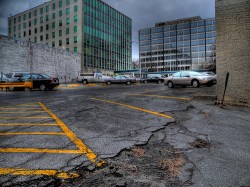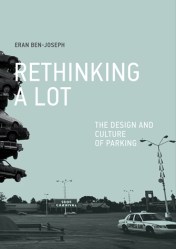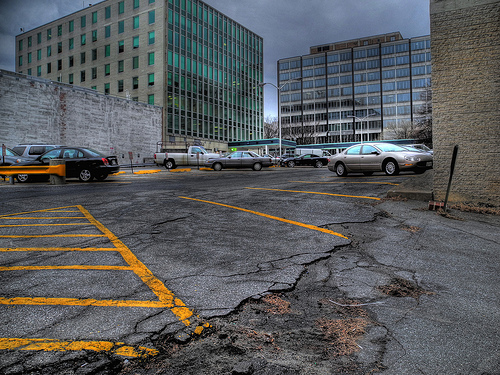A version of this story first appeared on The Dirt.

Photo by Matt Johnson.
It doesn’t matter whether you have a Prius or a Hummer, you have the same environmental impact. So argues MIT landscape architecture and planning professor Eran Ben-Joseph in his fascinating new book, ReThinking a Lot: The Design and Culture of Parking.
Whatever could he mean? Cars, on average, are immobile 95 percent of the time, taking up the same 9-by-18-foot paved rectangle. All of those paved spaces increase runoff into streams and wetlands, create heat islands, increase glare and light pollution, and shape the character of our cities.
To grasp the magnitude of the problem, consider that there are 500 million surface parking lots in the U.S. alone. In some cities, parking lots take up one-third of all land area, “becoming the single most salient landscape feature of our built environment,” Ben-Joseph writes.
But to this day, he says, “parking lots are considered a necessary evil; unsightly, but essential to the market success of most developments.” So the time is definitely ripe to redesign the lot.
Therein lies the material for an incredibly boring book, you might be thinking. But Ben-Joseph’s book is so clearly written and designed and includes such great photos you’ll find yourself drawn in.
 Take the history, for example. Back in 705 B.C., Assyrian King Sennacherib posted signs on his highway to ensure it was cleared of parked chariots. The signs read: “Royal Road — let no man decrease it.” Whereas nowadays, you’d just get a ticket, then an improperly parked chariot could result in death by beheading. Later, the Romans actually implemented parking laws. Julius Caesar instituted rules preventing chariots from entering busy commercial zones during peak hours to limit congestion.
Take the history, for example. Back in 705 B.C., Assyrian King Sennacherib posted signs on his highway to ensure it was cleared of parked chariots. The signs read: “Royal Road — let no man decrease it.” Whereas nowadays, you’d just get a ticket, then an improperly parked chariot could result in death by beheading. Later, the Romans actually implemented parking laws. Julius Caesar instituted rules preventing chariots from entering busy commercial zones during peak hours to limit congestion.
Two millennia later, as cars, the “horseless chariots,” overtook horse-drawn carriages, they started to consume too much road space, so needed to be stored somewhere. To “ease this ever-growing need,” municipalities and entrepreneurs started to offer off-street parking.
Beginning in the 1930s, off-street parking began to appear in planning and urban zoning strategies. Guidelines were produced over the years, culminating in the Institute of Transportation Engineers’ handbooks Trip Generation and Parking Generation in the 1980s, which Ben-Joseph says are still the go-to guidelines for many transportation and community planners. The guides helps communities estimate the number of parking spaces needed for a particular development. The only problem: A simplistic use of these guides alone has resulted in masses of underutilized parking lots.
The aesthetics of a parking lot were considered important back in the 1920s to 1940s, but over the years, the design of these spaces was increasingly left up to developers. Even very progressive cities like Cambridge, Mass., offer over 30 pages of regulations on parking lots’ size and organization, but no rules about how they should look. The result was that many developers simply cut corners, creating oceans of these “generic, ordinary spaces.”
All of those parking lots are not only expensive but represent an opportunity lost. The average parking lot cost is $4,000 per space, with a space in an above-grade structure costing $20,000, and a space in an underground garage $30,000-$40,000. To give us some sense of the opportunity lost, Ben-Joseph says 1,713 square miles (the estimated size of all surface parking lots in the U.S. put together) could instead be used for spaces that generate 1 billion kilowatt-hours of solar power. With just 50 percent of that space covered with trees, this space could handle 2 billion cubic meters of stormwater runoff, generate 822,264 tons of oxygen, and remove 1.2 million tons of carbon dioxide annually.
Still, so few communities impose even basic landscape requirements to make these places just a bit more green and permeable. Ben-Joseph points to many well-designed examples created by landscape architects and artists, but unfortunately, they remain very rare birds. In Turin, Italy, Renzo Piano created a beautiful parking lot without parking islands and curbs, just rows of trees in dense grids intermingled among the spaces. Other high-performing parking lots incorporate solar panels or wind turbines, add new trees or even preserve old ones, and incorporate bioswales and permeable pavement. One parking lot in Duck, N.C., is even designed to serve as a detention pond during minor flooding.
Beyond the environmental benefits, more flexible parking spaces help communities build social connections. Already, as Ben-Joseph notes, in parking lots, children learn how to ride bicycles, teenagers learn how to drive cars, and high school students hang out after school “where the drama of youth plays out.” In many communities, farmers markets and flea markets take over lots on weekends. In Manhattan’s Lower East Side, there’s Shakespeare in a Parking Lot. Outside of stadiums, there are tailgating parties. In Walmart lots, you can find RVs “boon-docking.” In a number of cities, festivals of food trucks turn a sad parking lot into a space for food, beer, and bands.
What’s important is that community leaders and planners actually enable these activities and remake regulations so that parking areas can provide multiple social functions.
Parking lots can also become sites for activism. San Francisco landscape architect John Bela created the nonprofit Rebar and launched the annual Park(ing) Day, which has become a global movement. In 2009, some 700 parking spaces were designed as mini-parks in 21 countries and 140 cities. Some have even been made permanent in San Francisco, Vancouver, and other cities. These spaces can also become sites for art. Martha Schwartz created a funky parking lot for an amusement park, while artist Toshihiro Katayama and landscape architecture firm Halvorson Design created a stunning shared space for cars and pedestrians in Boston.
Unfortunately, once you exclude the small share of well-designed lots, the average parking space hasn’t really changed much since the 1950s. Still, these bland expanses of asphalt aren’t “no-places,” and they could still be so much more. Don’t believe it? Read this book. I promise you’ll be pleasantly surprised.




